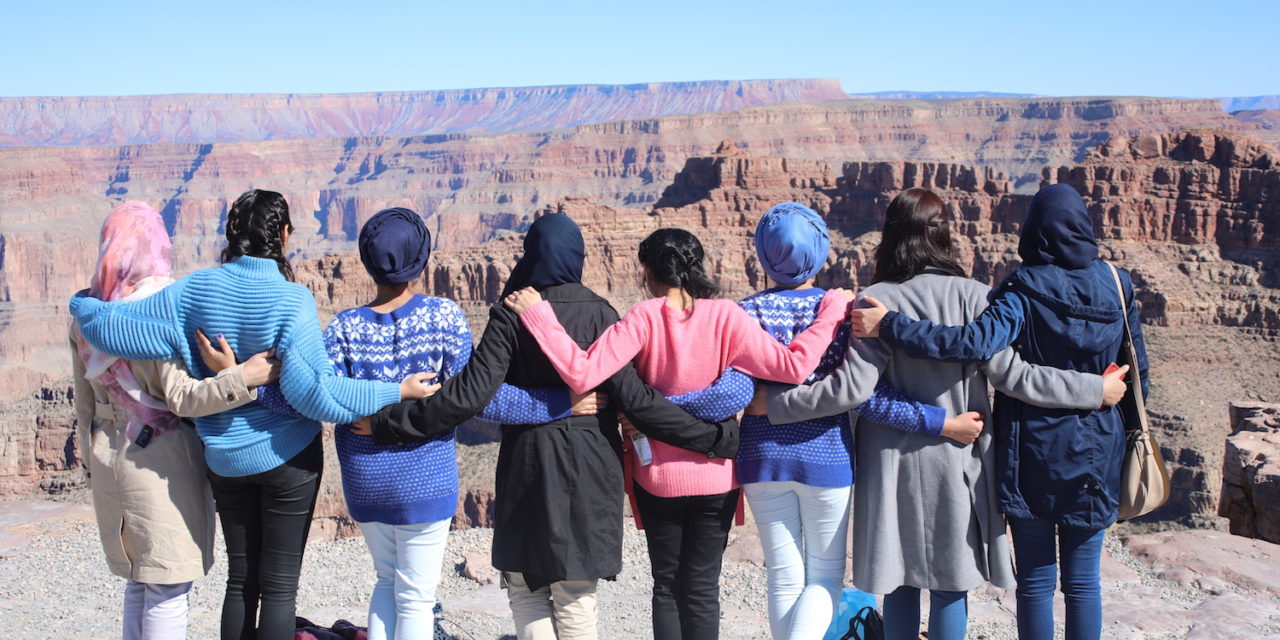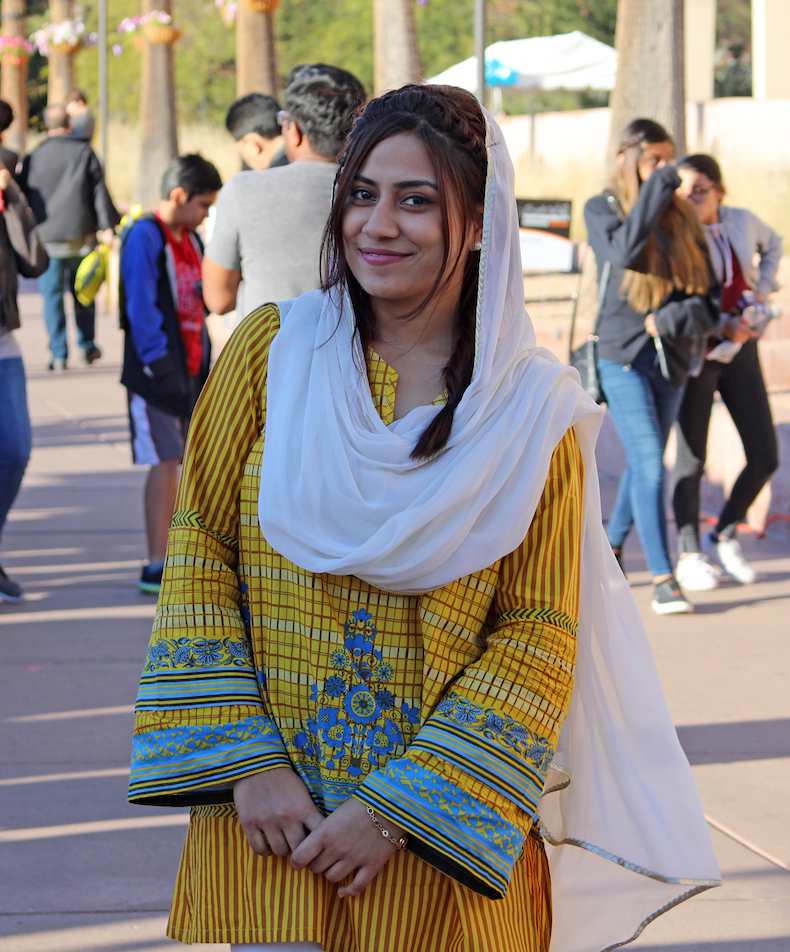
Power of exchange: Proximity creates possibilities

Above: Each semester, USPCASE exchange students go on a week-long trek across the Western United States to visit places like the Hoover Dam, the Grand Canyon and Disneyland. Photo courtesy of USPCASE
Exchange programs are a critical part of the knowledge transfer that is taking place among the partner institutions that make up the U.S.-Pakistan Centers for Advanced Studies in Energy, known as USPCASE. More than 200 students and faculty from NUST and UET will visit the United States for a semester-long research and cultural exchange experience during the life of the project.
Imagine being an engineer who couldn’t conduct research, a scientist who couldn’t perform vital experiments in a lab. That’s the reality for some of Pakistan’s brightest science and technology scholars, but not for those who come to the U.S. to study at Arizona State University as part of USPCASE
Through USPCASE, a few dozen Pakistani scholars spend a semester hitting the books in their chosen fields at ASU, learning about U.S. culture and – to the delight of people like thermal engineering student Muhammad Zia Ullah Khan – gaining hands-on experience in a university laboratory. Khan called working in the lab “the main opportunity” he enjoyed as an exchange student. Back home, students often aren’t allowed to use university lab equipment.
Khan also called learning the culture very important, and that’s a key component to the USPCASE exchange program. Participants do more than expand their technical proficiency. They also acquire perspective and skills that will help them meet some of the pressing electricity shortages that now plague the Pakistani people.
From lack to leadership
“Pakistan has 200 million people in a relatively small country that’s super-densely populated and has an insecure supply of electricity,” notes Zachary Holman, assistant professor in ASU’s Ira A. Fulton Schools of Engineering.
Although the government has added electricity generation capacity in recent years, population growth has outpaced that capacity, and the nation still endures rolling power outages throughout areas beyond big-city limits.
“When you don’t have access to regular electricity, there are a lot of things you can’t do,” Holman says. Adverse effects to industry, refrigeration and hospital operations are a few of the outcomes he mentions, adding that, “you can’t have a productive society,” which impacts societal prosperity and stability.
“The students who come through the USPCASE program are supposed to be the next generation of engineers in Pakistan. They need to know a lot more than just how solar cells work,” he adds.
Much of that extra learning comes from studying abroad.
“There are three components to the exchange program,” says Andrew Sarracino, international visits coordinator for USPCASE. “The first is training, the second is professional development, and the third is cross-cultural activity.”
In the USPCASE program, that cross-cultural exchange involves Pakistani students studying in the United States, Pakistani faculty conducting research here, as well, plus there is a series of workshops in which ASU professors go to Pakistan to teach in-country.
Why are such cross-cultural activities important? In part, because they solidify relationships.
“There is much and repeated interaction between the students and the faculty in Pakistan and ASU,” Holman says. “There also are opportunities for research and education collaboration that can take place between ASU and the Pakistani universities funded by USAID [the government agency backing the USPCASE program]. It’s hard to start something with someone you don’t know.”
Changing minds
As Sarracino notes, professional development is a big part of the USPCASE program. To that end, students must take classes in energy policy and entrepreneurship.
“They’re supposed to be learning things beyond book and lab skills,” says Holman. “They’re gaining skills that will help them go back to Pakistan and really have impact.”
Ken Mulligan teaches classes on entrepreneurship at ASU and is among the instructors imparting such skills.
“One of the challenges in Pakistan is that they are a nation of job seekers, not a nation of job creators,” Mulligan says. “How do you drive economic growth? You drive it through entrepreneurship and innovation.”
According to Mulligan, changing mindsets is a major challenge for Pakistan.
“Engineers are trained as problem solvers. They use the waterfall analytic method for problem solving. It’s all formulaic. They look at a problem and they just apply principles and formulas to solve it,” he says. But, he adds that entrepreneurship is about value creation, the act of producing “real value for real people. You and I as individual consumers: What things will make our lives better in terms of convenience, comfort and basic economics?”
This is a key question Mulligan brings to his classrooms at ASU and workshops in Pakistan. “It’s a hard lesson for engineers,” he says. “There are a lot of vagaries and uncertainties attached to advancing an idea from a napkin sketch to a finished product. People who are attracted to engineering tend to like well-defined answers. They like the formula that gives them the same answer every single time. They’re curious, they like to investigate, but they don’t like uncertainty, and entrepreneurship has a lot of it.”
Still, Mulligan is determined to help his students move from problem solvers to solution and job creators.
“My mission is to empower the students to have a vision for value creation and understand that their role is to do good from their knowledge base,” he says. “I tell them, ‘Why not you? Why shouldn’t you be the person who leads the way to a new and better Pakistan?’”
Learning to speak up

Maria Kanwal, an exchange student from Pakistan’s National University of Science and Technology (NUST), was part of USPCASE’s fifth cohort in spring 2018. Photo courtesy of USPCASE
After teaching Pakistani students both abroad and in ASU classrooms, Holman says that one of the biggest benefits exchange offers is “seeing a different way of doing things.”
As previously noted, lab work is a new experience for most of the exchange students.
“They always tell me when they leave that the most valuable thing for them was being given the freedom and responsibility to use pieces of equipment on their own,” Holman says.
Some of those pieces of equipment are worth more than $1 million.
“To the students, this is a complete revelation because even when they have equipment, often students aren’t allowed to use it. Sometimes that’s about resources, but a lot of it is about a different system and culture.”
Hands-on experiences present a different learning mechanism than book and classroom learning.
Maria Kanwal, an exchange student from Pakistan’s National University of Science and Technology (NUST), says her time in the materials science lab enhances her research proficiency: “I have learned quite a few techniques that I had previously been introduced to only theoretically,” she says.
In addition, lab work expanded Kanwal’s knowledge of materials science. That’s Holman’s research area, and he explains that it’s all about finding new materials to use, putting them together to make solar cells, then “finding out how they perform in real-world conditions. You need to do those things to improve efficiency and reliability.”
Kanwal describes the work in the energy materials lab as a place “where novel solar cell technologies are being developed. Exposure to this facility has broadened my horizons about the room for improvement in the current technology.”
Up and out
Lab work isn’t the only way Pakistani students are educated and empowered by the exchange program. In the classroom, they’re taught to speak up and expected to do so in weekly presentations. Although many students begin this requirement with considerable shyness, Mulligan teaches his students that it’s “an opportunity.”
“If you can get over this fear and learn how to package your ideas in a way that people understand and respond to, you’ll create more opportunity for yourself and you’ll do more good.”
Another learning experience comes from stateside travel. Each semester, Sarracino arranges and chaperones a week-long trek across the Western United States in which exchange students visit places like the Hoover Dam, the Grand Canyon and Disneyland.
“The purpose of this is for students to realize the potential that they could implement through tourism, land conservation and economic development in their home country,” Sarracino says. “For instance, going to the Grand Canyon, students were able to see how the Hualapai Tribe, a Native American entity, was able to leverage natural resources and turn that into a tourism enterprise.”
Some of the eye-openers exchange students experience relate more to culture than commercialism.
Sarracino recalls the person who needed shampoo and was stunned to discover Walmart offered up a whole aisle of options. Another couldn’t get over how many cars exist in the U.S.
“One day we were driving by a six-story parking garage and I said to the student, ‘See that building? That is for parking cars,’” Sarracino recalls. “It blew his mind.”
Many students, including Muhammad Khan, report astonishment at the number of well-managed festivals they were able to attend while at ASU.
“They’re surprised at how the festivals are run in the U.S.,” Sarracino notes. “One individual pointed out that waste management gets involved. There are trash cans all around, there are ATMs and food trucks … it’s all so organized.”
Respect for others is another by-product of the exchange.
“I have found that persons in the U.S.A. are hard-working,” Khan says. “During the working day, I hardly notice anyone moving around freely. They stick to their work. On the weekend, they enjoy themselves. They value time.”
Khan and Kanwal – both from NUST – were selected for the exchange program through a competitive process that brought only 15 of 90 potential travelers to the U.S. Each of these students will leave ASU with renewed commitment to apply their knowledge to help their country.
Kanwal reports this goal: “I wish for Pakistan to make use of the huge solar potential that it has.”
Khan has similar service-oriented ambitions.
“The job I’m aiming to pursue in Pakistan is related to research and development,” he says. “I could implement my knowledge to help eradicate Pakistan’s energy crisis.”
Written by Betsy Loeff
This article appeared in the USPCASE Energizer newsletter, uspcase.asu.edu/newsletters.
To learn more about the U.S.-Pakistan Centers for Advanced Studies in Energy, visit uspcase.asu.edu.



































